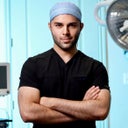Posted underEyelid Surgery q&a
I have Bells Palsy 1 month now. My right eye looks significantly bigger maybe even swollen any thoughts on what to do? (photo)
I may have just noticed the size today due to the fact that I actually put on eyeliner for the first time possibly making the difference more noticeable. Please note that my eye doesn't hurt at all and I can blink almost normal. It also closes slowly all the way
Answers (4)
From board-certified doctors and trusted medical professionals
Dr. Mark L. Mazow, MD, FACS
Oculoplastic Surgeon, Board Certified in Ophthalmology
Answer
Dr. Flora Levin, MD, FACS
Oculoplastic Surgeon, Board Certified in Ophthalmology
Answer
Dr. Sara A. Kaltreider, MD (retired)
Oculoplastic Surgeon, Board Certified in Ophthalmology
Answer
More Eyelid Surgery Questions
See all Eyelid Surgery Q&AWE SEND PRETTY
EMAILS
What’s trending? Who’s turning heads? Which TikTok myths need busting? We’ve got you. No fluff, no gatekeeping—just real talk. Get our free, unfiltered newsletter.
